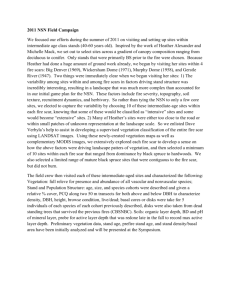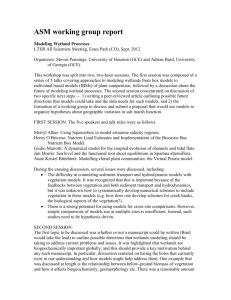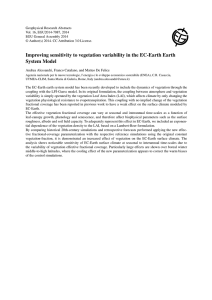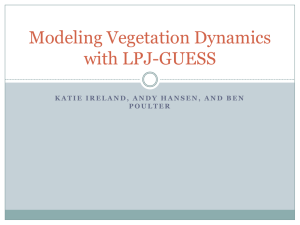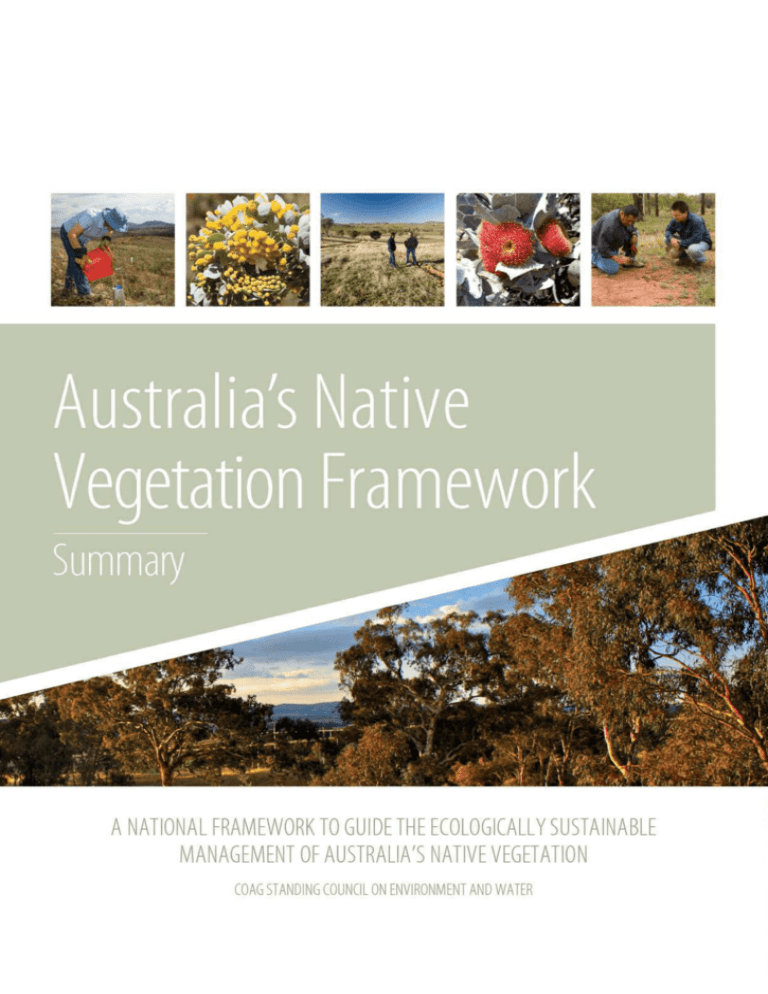
The framework’s vision
Native vegetation across the Australian landscape is
managed in an ecologically sustainable way in recognition
of its enduring environmental, economic, social, cultural and
spiritual values.
Australia’s Native Vegetation Framework
Australia’s Native Vegetation Framework has been developed by the Australian Government and state and
territory governments to maintain or build healthier and more connected native vegetation. The framework is a
strategic document with five goals to guide government, the community and the private sector in native
vegetation management across Australia. It is not prescriptive or binding.
Governments across Australia are working together to implement the framework as well as to monitor and
report on progress. The COAG Standing Council on Environment and Water will formally oversee
implementation of the framework and coordinate regular reviews and updates.
National goals for native
vegetation management
The five goals and supporting targets of Australia’s Native Vegetation Framework are vital for long-term
sustainable management of native vegetation. The goals will guide us in maintaining ecosystem resilience,
improving the productive capacity of the land and promoting healthy ecosystem function across the landscape.
Realising the framework goals will involve people from all levels of governance, the business and industry
sectors, private landholders and the community.
National Goals
Goal 1. Increase the national extent and connectivity of native vegetation
Goal 2. Maintain and improve the condition and function of native vegetation
Goal 3. Maximise the native vegetation benefits of ecosystem service markets
Goal 4. Build capacity to understand, value and manage native vegetation
Goal 5. Advance the engagement and inclusion of Indigenous peoples in management of native vegetation
Wildflowers at Mount Hotham, VIC (Photo by Trevor J Ierino)
2
Kangaroo Grass (Themeda australis) on Carnarvon Station, QLD (Photo by Dragi Markovic)
Why is native vegetation important?
Ecological value — Australia’s native vegetation is extraordinarily diverse, rich in species and complexity
and has many unique physical features. About 85 per cent of Australia’s plant species are endemic to the
continent. Native vegetation is a vital component of Australia’s biodiversity. It plays a crucial role in
sustaining ecosystem function and processes, buffering the impacts of harsh and extremely variable climates,
binding and nourishing soils, cleansing the air and filtering water.
Economic value — Economically, native vegetation and its direct soil and water functions support the
productive capacity of many important sectors of the Australian economy. These include agriculture, forestry,
fisheries and aquaculture and tourism. Native vegetation management also has the potential to generate
significant employment and enterprise development opportunities for rural and regional Australians including
Indigenous peoples, for example as part of sustainable agriculture.
Social and cultural value — Native vegetation shapes the Australian culture and national identity.
For Indigenous Australians, the land and its resources have underpinned Indigenous history, innovation,
culture, spirituality and economics for tens of thousands of years.
Why do we need a plan of action?
Native vegetation is of value to all Australians. In many parts of Australia, however, it has been cleared or
degraded and fragmented as a result of human activity and influence.
According to the Australia state of the environment 2011 report
only around 25 per cent of Australia’s original estimated extent of native vegetation remains intact
62 per cent has been subject to disturbance and modification
13 per cent has been completely converted to other land uses, predominantly agriculture.
Threats to native vegetation have potentially serious consequences for Australia. The impact of these threats
includes the decline of biodiversity and reduced ecosystem functioning, reduced water quality, increased
erosion and salinity, increased greenhouse gas emissions, reduced productivity and impacts on cultural
and spiritual identity.
Over the years, Australian governments, industry and the community have invested significantly in the
sustainable use and conservation of native vegetation. Nevertheless, further action is needed from all land
users and managers to achieve the long-term sustainability of Australia’s native vegetation.
Australia’s Native Vegetation Framework guides the way to an Australian landscape that maintains and
promotes healthy, diverse and connected native vegetation communities, while providing environmental,
social and economic benefits for all Australians.
3
Goal 1: Increase the national extent and connectivity of
native vegetation
Because it is difficult to put back native vegetation once lost, we need to retain and protect existing native
vegetation communities as the first priority for management. In extensively cleared landscapes, regeneration and
revegetation will also be needed to connect and extend native vegetation to improve landscape function.
Achieving this important goal will require widespread collaboration between land managers, the community,
non-government organisations, industry and all Australian governments.
Targets
Target 1: By 2014 all Australian state and territory governments will have developed targets for the extent of
native vegetation in their jurisdictions.
Target 2: By 2016 targets for native vegetation extent will have been recognised and reflected by all tiers of
government and regional organisations in environment and natural resource management planning, land use
planning and land management.
Target 3: By 2020 there will be a net national increase in the extent of native vegetation, including where it can
contribute to landscape connectivity.
Case Study: The Gondwana Link program — towards 1000 km
of ecologically functioning landscape
The Gondwana Link program, established in 2002, is a landscape-scale vision to restore ecological connectivity
across south-west Western Australia, and to build a ‘living link’ that extends eastward across part of the
continent. The connectivity conservation area covers more than 20 million hectares over a 1000 kilometre
swathe of habitats — from the Karri forests of the south-west across the Great Western Woodlands to the edge
of the Nullarbor Plain and beyond. More than 900 kilometres of this remains structurally intact and holds more
than 75 per cent of the flowering plant taxa of the south west botanical hotspot. It is also arguably the part of the
south west most buffered from accelerated climate change.
In the agricultural sections of Gondwana Link, more than 8000 hectares of strategically located bushland have
been protected and some 2400 hectares of paddock restored. In one key section of the link, between Fitzgerald
River and Stirling Range National Parks, the cleared gaps between secure habitat areas have already been
reduced by an average of 55 per cent.
The Gondwana Link program involves collaboration across a wide spectrum of private sector organisations,
at local, national and international levels. For more information see: www.gondwanalink.org/
Tree plantings on the raised shoreline at the Kitty Miller Wetlands, Phillip Island, VIC (Photo by John Baker)
4
Goal 2: Maintain and improve the condition and function of
native vegetation
Managing the threats to native vegetation condition and ecosystem function is critical for Australia’s ecosystems.
Working to improve the condition and function of native vegetation will promote and maintain a healthy and
resilient landscape, and will support both biodiversity and the productive capacity of land into the future.
Targets
Target 4: By 2014 agreed protocols are in place and by 2016 monitoring systems are in place to measure changes
in the condition of representative native vegetation communities across Australia.
Target 5: By 2015 strategic plans are developed for Australia’s native vegetation, including plans aimed at
reducing priority threats to condition and their underlying drivers.
Target 6: By 2025 there will be a net national improvement in condition of native vegetation.
Caring for our Country — Environmental Stewardship
The Environmental Stewardship Program is an element of the Australian Government’s Caring for our Country
initiative. It focuses on creating markets for the purchase of long-term conservation improvements on private
land. Under the program, eligible land managers can receive funding for up to 15 years to undertake agreed
conservation management actions. Since 2008, the Environmental Stewardship Program has been working with
land managers to protect and restore more than 58 000 hectares of endangered and critically endangered
ecological communities. During 2011–2012 the program delivered its second funding round targeting ecological
communities in South Australia, building on the earlier program work in New South Wales and Queensland.
Environmental assets targeted through the program are matters of national environmental significance listed
under the Environment Protection and Biodiversity Conservation Act 1999. For more information see:
www.nrm.gov.au/stewardship
Goal 3: Maximise the native vegetation benefits of ecosystem
service markets
Ecosystem service markets provide important opportunities for improving native vegetation and biodiversity
outcomes. Market-based instruments can place an economic value on ecosystem services, and thereby provide
economic incentives for environmental protection and actions, as well as an alternative revenue stream for land
users and managers. They will be particularly important as we face the challenges of climate change.
Targets
Target 7: By 2014 systems and guidelines have been developed for accreditation and reporting of the
biodiversity co-benefits of carbon markets.
Target 8: By 2015 credible and consistent accounting tools are developed to measure and report on carbon
sequestration and avoidance initiatives across Australia, related to the establishment and management of native
vegetation communities, including permanent, biodiverse, locally native plantings.
5
Goal 4: Build capacity to understand, value and manage native
vegetation
Engaging all Australians is important if we are to succeed in achieving the vision of the framework. People play a
central role in the management of native vegetation; particularly private and leasehold land managers and
Indigenous Australians as custodians of large land areas across Australia. Strategic actions to increase the capacity of
people, networks and infrastructures will improve our ability to effectively manage and protect Australia’s native
vegetation.
Targets
Target 9: By 2014 targeted communication programs and community engagement programs are in place to enable
a range of stakeholder groups to better understand the values of native vegetation.
Target 10: By 2016 there has been an increase in the number of Australians who understand the benefits and
values of native vegetation.
Target 11: By 2016 major public and private land managers and industries recognise the benefits of native
vegetation by undertaking practices that promote the ecologically sustainable management of native vegetation.
Goal 5: Advance the engagement and inclusion of Indigenous
peoples in management of native vegetation
Indigenous ecological knowledge has an important role to play in native vegetation management. Indigenous
Australians are already significant contributors to biodiversity conservation and native vegetation management,
managing an estimated 23 per cent of Australia including some of our most biodiverse and intact ecosystems.
Targets
Target 12: By 2014 Indigenous peoples have been engaged in developing culturally appropriate approaches to
their involvement in native vegetation management across Australia.
Target 13: By 2016 culturally appropriate approaches have been implemented that involve Indigenous peoples in
native vegetation management.
Target 14: By 2016 relevant decision-makers in all levels of government understand the significance of native
vegetation to Indigenous peoples and reflect this in decision making.
Case Study: The ACT Caring for the Cotter River
Catchment Project
The ACT Government and the Ngunnawal people are working together in a cross-cultural partnership aimed at
restoring and protecting the Cotter River catchment west of Canberra. Indigenous trainees with the ACT
Government — known as the Yurung Dhaura team — work to restore high value ecosystems and achieve various
conservation targets.
A key feature of the project is the combination of traditional knowledge and vocational training. Trainees undertake
tertiary studies and work with the Ngunnawal people to document their traditional ecological knowledge and to
apply this, with permission, to biodiversity conservation within the catchment.
The team has already exceeded some restoration targets including managing feral animals over more than
200 hectares, completing more than 50 hectares of weed control, including removal of dense thickets of pine
wildlings in a 10 hectare area of Xanthorrhoea (grass trees) and planted nearly 6 hectares of bare ground to native
trees and shrubs.
6
What can we do?
The framework calls for the collaborative effort of all Australians to manage and protect our native vegetation
sustainably for future generations. Collectively, we have the knowledge, skills, capacity and community
momentum to tackle biodiversity decline and the degradation of native vegetation. It is important that we use a
mixture of different types of actions and draw from a broad pool of resources and support to achieve the goals of
the framework.
Threats to native vegetation
loss, fragmentation and degradation of habitat
unsustainable use of natural resources
invasive species
changes to the aquatic environment and water flows
inappropriate fire regimes
urban development
lack of valuation of the environment
climate change
“Individually and collectively we can, and must, find ways of
living sustainably and without destroying the biodiversity
around us.”
Summary of Australia’s Biodiversity Conservation Strategy 2010–2030, NRMMC, 2010
Making changes
Government at all levels, businesses, communities, individuals, Indigenous peoples, researchers, private
landholders and non-government organisations all have a part to play in the conservation of native vegetation.
Across Australia there is important work already underway that contributes to the goals of the framework.
For example:
7
Community groups and non-government organisations, individuals and private and public landholders can
undertake activities that allow natural regeneration, or actively seed or plant areas of native vegetation to
buffer, link and improve vegetation function at a landscape scale.
State and territory and local governments can:
use strategic regional and land use planning to avoid unsustainable development; manage fire and fire
risk, considering both native vegetation and human needs; integrate native vegetation and change
land management practices towards sustainability; and integrate native vegetation and its sustainable
management into the urban and peri-urban environments.
implement initiatives that manage threats and promote sustainable native vegetation management
to improve the extent, connectivity and condition of native vegetation.
Private and public landholders could consider becoming involved in ecosystem service markets to achieve
biodiversity co-benefits.
All Australians, the private sector and governments can support and invest in businesses, industries
and private/public partnerships that prioritise and demonstrate good native vegetation management and
biodiversity conservation.
The vision of the framework will be achieved when our efforts
towards the goals of
the framework result in an Australian landscape that maintains
and promotes healthy, diverse and connected native vegetation
communities. This will, in turn, provide environmental, social
and economic benefits for all Australians.
The Department of Sustainability, Environment, Water, Population and Communities has prepared this publication on behalf of the
COAG Standing Council on Environment and Water.
More information and a copy of the framework is available at: http://www.environment.gov.au/nvf
Community Information Unit, Department of Sustainability, Environment, Water, Population and Communities
GPO Box 787, Canberra ACT 2601
Telephone: 1800 803 772
Email: ciu@environment.gov.au
Secretariat
Australia’s Native Vegetation Framework Review Task Group Secretariat
c/- National Biodiversity Section,
Biodiversity Policy Branch
Department of Sustainability, Environment, Water, Population and Communities
GPO Box 787, Canberra ACT 2601
References
COAG Standing Council on Environment and Water (2012) Australia’s Native Vegetation Framework, Australian
Government, Department of Sustainability, Environment, Water, Population and Communities, Canberra
www.environment.gov.au/nvf
Natural Resource Management Ministerial Council, NRMMC (2010) Australia’s Biodiversity Conservation Strategy 2010–
2030, Australian Government, Department of Sustainability, Environment, Water, Population and Communities, Canberra
www.environment.gov.au/biodiversity/strategy/index.html
© Standing Council on Environment and Water 2012
This work is copyright. You may download, display, print and reproduce this material in unaltered form only (retaining this
notice) for your personal, non-commercial use or use within your organisation. Selected passages may be reproduced provided
due acknowledgement is made. Permission will be required for the reproduction of any photographs. Apart from any use as
permitted under the Copyright Act 1968, all other rights are reserved. Requests and inquiries concerning reproduction and
rights should be addressed to the Secretariat.
The views and opinions expressed in this publication do not necessarily reflect those of the Commonwealth or the members of the COAG
Standing Council on Environment and Water and its associated committees, including the Native Vegetation Framework Review Task
Group.
Victoria supports the Framework in-principle and is not opposed to setting national directions relating to native vegetation management.
However, Victoria is currently reviewing the state native vegetation regulations and the Victorian Minister for Environment and Climate
Change is not in a position to consider endorsing the Framework until the Victorian review is complete.
The Commonwealth of Australia acting through the Department of Sustainability, Environment, Water, Population and Communities has
exercised due care and skill in the preparation and compilation of the information set out in this publication and the information provided in
this publication is considered to be correct at the time of publication. However changes in the circumstances after the time of publication
may impact on the accuracy of this information. The Commonwealth therefore disclaims all representations and warranties regarding the
currency, completeness, accuracy and suitability of the content of this publication and, disclaims all legal liability for any loss, damage,
expense and/or costs incurred by any person arising out of use of or reliance on this publication.
The Commonwealth recommends that users exercise their own skill and care with respect to their use of this publication and that users
carefully evaluate the accuracy, currency, completeness and relevance of the material in this publication for their purposes.
8





